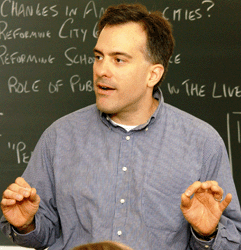Professor’s book ties origin of science fairs to call for more STEM education
GAINESVILLE, Fla. — A new book by a University of Florida education professor about science fairs and other extracurricular school science programs hits the shelves just as education in science, technology, engineering and math – the STEM disciplines – continues making headlines.
Sevan Terzian’s newly published book, Science Education and Citizenship, gives insight into the growing effort to improve science education by uncovering the history of science fairs, clubs and talent searches, such as Florida’s 58th annual State Science and Engineering Fair, set for March 26-28 in Lakeland.
“Science fairs, clubs and talent searches are familiar fixtures in American education, yet little has been known or written about why they began and grew in popularity,” said Terzian, an associate professor in social foundations of education at the University of Florida’s College of Education. He’s also associate director of graduate studies for the college’s School of Teaching and Learning.
His book, published in January by Palgrave Macmillan of New York City, traces the origins and civic purposes of American extracurricular programs dedicated to science between the 1920s and ‘50s.
“I think science fairs, clubs and talent searches are part of the rituals of school life,” Terzian said. “But it occurred to me that I did not know where they came from and why. When I began looking into that, that’s when it got exciting.”
Terzian said he found that the earliest programs between the 1920s and ‘30s were dedicated to encouraging students to understand the processes of scientific investigation so they would become more knowledgeable and involved American citizens
World War II, however, changed the landscape of extracurricular science activities. Terzian discovered that, as the United States mobilized for war, these science programs modified their activities to achieve a new overarching purpose: “to find the best and the brightest kids who could apply their expertise so the U.S. could win the war,” he said.
“The message these kids were hearing was, ‘We need you in order to win the war, to have a strong national defense, and to help the nation’s economy,’” Terzian said. “They would do all this by applying scientific knowledge to weapons or new technological innovations that would lead to material comforts for consumers.”
This goal continued well into the 1950s, and is still evident today, he said.
Terzian ‘s findings give perspective on the current movement to bolster science teaching and student achievement.
“Although we can all agree that high achievement in science is desirable in American education, we may not always spend enough time thinking why we think so,” Terzian said. “What exactly is it that we hope improved science education will give us?”
Terzian believes STEM education can serve many purposes, including the defense- and innovation-oriented reason that pervaded science education during World War II and the ensuing atomic age.
“STEM education should not be only for the future scientists,” Terzian said. “STEM education has the potential to cultivate rational thought, to encourage critical questioning, and even to foster empathy, which I think are essential characteristics of good citizens in a democratic society.”
To review or purchase Terzian’s new book, Science Education and Citizenship, visit the Palgrave Macmillan website.
CONTACTS
Source: Sevan Terzian, UF College of Education, sterzian@coe.ufl.edu, 352-273-4216
Writer: Alexa Lopez, news and communications, UF College of Education; akl@coe.ufl.edu; 352-273-4449
Media Relations: Larry Lansford, director, news and communications, UF College of Education; llansford@coe.ufl.edu; 352-273-4137





